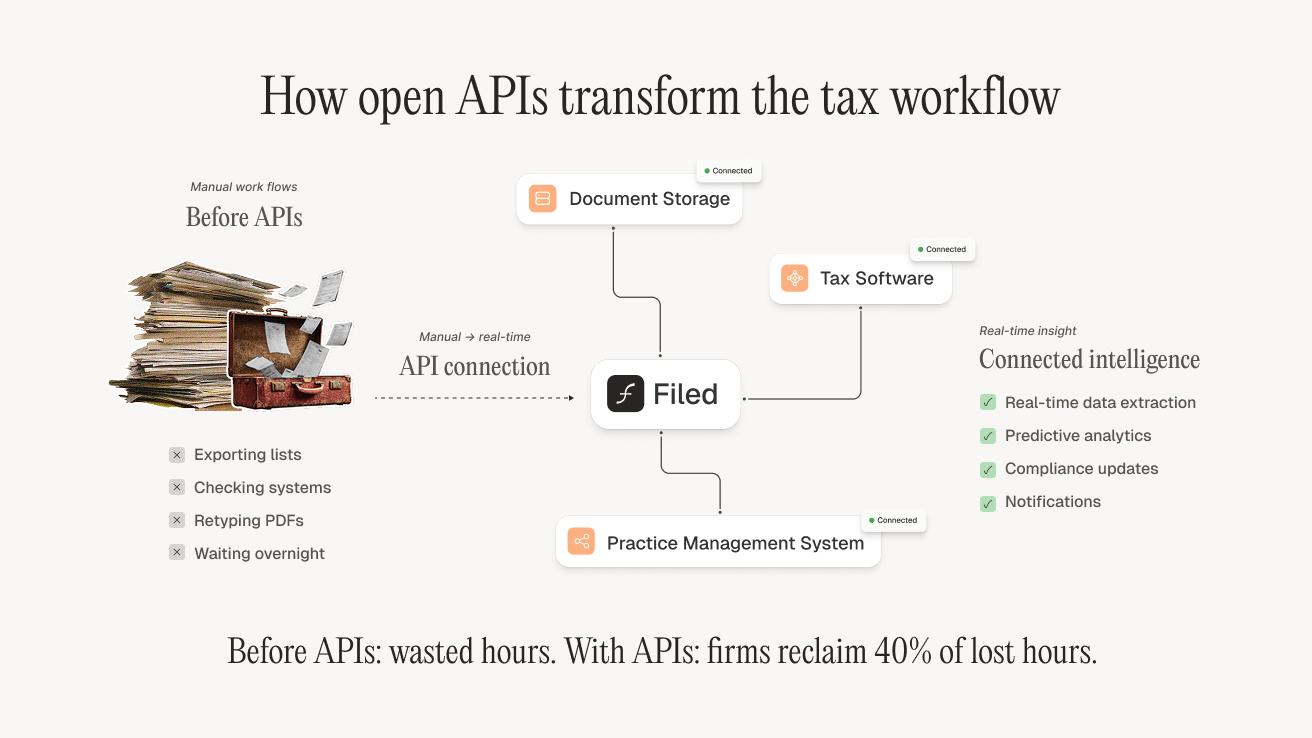Disconnected systems kill efficiency. When data gets trapped in silos, forcing staff to retype the same numbers into three platforms, errors creep in because no one has the full picture. That might have worked in 2005. In 2025, it’s a liability.
Clients want faster answers. Regulations shift weekly. Teams use more specialized tools than ever. If your systems can’t talk to each other, you’re burning time and losing trust.
Open APIs — the digital connectors that let your tax software sync with the rest of your workflow in real time — are the solution. And today, they’re not just “nice to have.” They’re non-negotiable.
The growing need for real-time tax data and interoperability
Batch processing is dead. Overnight updates and manual exports can’t keep up with shorter deadlines and higher client expectations. Without integrations, your “workflow” is just copy-paste with extra steps.
Firms using real-time integrations report up to 40% time savings on return prep. Gone are the days of duplicate data entry and repeated manual checks. Why would they settle for anything less than instant updates across systems?
The key drivers behind this shift include:
- Growing data volume: Tax forms and reporting requirements expand every year
- Client expectations: Clients want faster answers and updates on their tax situation
- Tighter deadlines: Government agencies are shortening response windows for notices
- Multi-platform workflows: Teams use more specialized tools that need to share information
Real-time data flow is becoming the new standard.
Understanding open APIs in tax software
Think of APIs (Application Programming Interfaces) as digital doorways that let different software programs talk to each other.
There are two types: closed and open. Closed APIs only allow you to connect with vendors on the “approved list.” Open APIs plug into any compatible system, allowing you to choose the tools.
For tax pros, open API means:
- Client data moves automatically from your CRM into prep software.
- Document storage pushes files straight into the workflow.
- Updates flow instantly instead of waiting on batch transfers.
If you’re not using open API now, the impact can be huge.
Why open APIs and AI are reshaping tax firms
Open APIs don’t just connect systems — they fuel AI. AI can’t work without data, and APIs feed it. Together, they reshape tax workflows. Here’s what that reshaping looks like:

AI-driven data extraction
- Reads forms automatically (W-2s, 1099s, K-1s)
- Finds the numbers that matter
- Maps them into the right fields
Result: 2–3 hours saved per return for a mid-size firm, with 95%+ accuracy.
Predictive analytics for planning
APIs let AI pull real-time data to:
- Spot potential audit triggers before filing
- Identify tax-saving opportunities
- Project future tax liabilities using real-time financial data
Automated compliance updates
Tax laws change constantly at federal, state, and local levels. APIs allow tax software to connect directly to regulatory databases and update compliance rules automatically.
That means when the IRS changes a form or a state adjusts its tax rates, API-connected systems can:
- Update tax calculations immediately
- Adjust forms and worksheets automatically
- Alert professionals to returns that might be affected
Less risk of using outdated rules and less time spent constantly monitoring regulatory changes manually.
Key security considerations for open integrations
Integrations don’t excuse sloppy security. Open APIs must lock data down with:
- End-to-end encryption — Data is scrambled in transit, unreadable to anyone else.
- Role-based access — Staff only see what they need for their specific role.
- Multi-factor authentication — Passwords aren’t enough.
- Audit logs — Detailed records prove who accessed what, when.
And yes, APIs still have to align with IRS rules, SOC 2, GDPR, CCPA, and state privacy laws. Open doesn’t mean exposed.
Practical steps to implement open APIs successfully
Moving to API-connected tax systems doesn't have to be complicated. Here's a practical approach that works for firms of all sizes.
- Assess your current stack. List your systems, find the manual re-entry points, and measure the time wasted.
- Identify high-value API integrations. Client portal → prep software. Doc management → tax workflow. Accounting → prep platform.
- Testing and scalability. Validate data accuracy, stress-test performance, and confirm scalability (2x your normal load) before tax season.
- Plan for growth. If the integration can’t handle more clients next year, it’s not worth building today.
Future proofing your tax practice beyond 2025
The firms staying ahead aren’t just using APIs to connect tools — they’re using them to transform client service.
- Real-time collaboration: Preparers, reviewers, and clients working in the same return simultaneously.
- Advisory at scale: AI simulations and alerts powered by integrated data.
- Proactive service: Clients get notified of changes before they call you.
That’s the difference between firms barely meeting deadlines and firms building trust year-round.
The final word on open APIs and tax innovation
Open APIs turn disconnected tools into a connected ecosystem. That means no more retyping, no more data silos, and no more review bottlenecks.
Filed is built on open APIs. We plug into your existing stack, automate the grunt work, and give your team review-ready returns in real time. Apply for early access at Filed.com/early-access.
FAQs about open APIs in tax software
How do APIs improve tax workflow efficiency?
They eliminate manual entry between systems, cutting prep time by up to 50%.
What security standards apply?
SOC 2 compliance, TLS 1.2+ encryption, OAuth 2.0 verification, and audit logs.
How do firms measure ROI on integrations?
Track time saved per return, reduction in errors, increased seasonal capacity, and ability to handle more complex returns without new hires.




.png)

